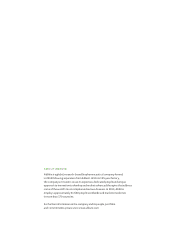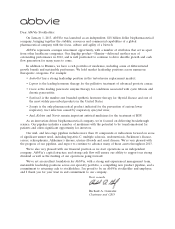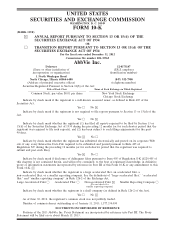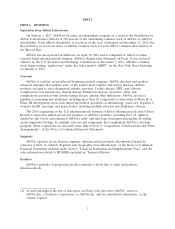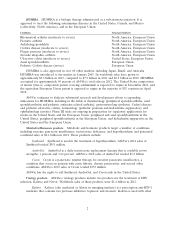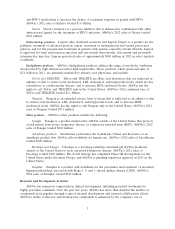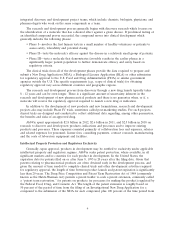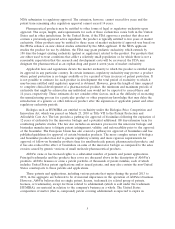AbbVie 2012 Annual Report Download - page 11
Download and view the complete annual report
Please find page 11 of the 2012 AbbVie annual report below. You can navigate through the pages in the report by either clicking on the pages listed below, or by using the keyword search tool below to find specific information within the annual report.NDA submission to regulatory approval. The extension, however, cannot exceed five years and the
patent term remaining after regulatory approval cannot exceed 14 years.
Pharmaceutical products may be entitled to other forms of legal or regulatory exclusivity upon
approval. The scope, length, and requirements for each of these exclusivities varies both in the United
States and in other jurisdictions. In the United States, if the FDA approves a product that does not
contain a previously-approved active ingredient, the product is typically entitled to five years of market
exclusivity. Other products may be entitled to three years of market exclusivity if approval was based on
the FDA’s reliance on new clinical studies submitted by the NDA applicant. If the NDA applicant
studies the product for use by children, the FDA may grant pediatric exclusivity, which extends by
180 days the longest existing exclusivity (patent or regulatory) related to the product. For products that
are either used to treat conditions that afflict a relatively small population or for which there is not a
reasonable expectation that the research and development costs will be recovered, the FDA may
designate the pharmaceutical as an orphan drug and grant it seven years of market exclusivity.
Applicable laws and regulations dictate the market exclusivity to which the product is entitled upon
its approval in any particular country. In certain instances, regulatory exclusivity may protect a product
where patent protection is no longer available or for a period of time in excess of patent protection. It
is not possible to estimate for each product in development the total period of exclusivity to which it
may become entitled until regulatory approval is obtained. However, given the length of time required
to complete clinical development of a pharmaceutical product, the minimum and maximum periods of
exclusivity that might be achieved in any individual case would not be expected to exceed three and
14 years, respectively. These estimates do not consider other factors, such as the difficulty of recreating
the manufacturing process for a particular product or other proprietary knowledge that may delay the
introduction of a generic or other follow-on product after the expiration of applicable patent and other
regulatory exclusivity periods.
Biologics such as HUMIRA are entitled to exclusivity under the Biologics Price Competition and
Innovation Act, which was passed on March 23, 2010 as Title VII to the Patient Protection and
Affordable Care Act. The law provides a pathway for approval of biosimilars following the expiration of
12 years of exclusivity for the innovator biologic and a potential additional 180 day-extension term for
conducting pediatric studies. The law also includes an extensive process for the innovator biologic and
biosimilar manufacturer to litigate patent infringement, validity, and enforceability prior to the approval
of the biosimilar. The European Union has also created a pathway for approval of biosimilars and has
published guidelines for approval of certain biosimilar products. The more complex nature of biologics
and biosimilar products has led to greater regulatory scrutiny and more rigorous requirements for
approval of follow-on biosimilar products than for small-molecule generic pharmaceutical products, and
it has also reduced the effect of biosimilars on sales of the innovator biologic as compared to the sales
erosion caused by generic versions of small molecule pharmaceutical products.
AbbVie owns or has licensed rights to a substantial number of patents and patent applications.
Principal trademarks and the products they cover are discussed above in the description of AbbVie’s
products. AbbVie licenses or owns a patent portfolio of thousands of patent families, each of which
includes United States patent applications and/or issued patents, and may also contain the non-United
States counterparts to these patents and applications.
These patents and applications, including various patents that expire during the period 2013 to
2031, in the aggregate are believed to be of material importance in the operation of AbbVie’s business.
However, AbbVie believes that no single patent, license, trademark (or related group of patents,
licenses, or trademarks), except for those related to adalimumab (which is sold under the trademark
HUMIRA), are material in relation to the company’s business as a whole. The United States
composition of matter (that is, compound) patent covering adalimumab is expected to expire in
5


